Leads4Pass shares the latest Fortinet NSE7_EFW-7.2 exam questions and answers (https://www.leads4pass.com/nse7_efw-7-2.html) to help you effectively prepare for the Fortinet NSE 7 – Enterprise Firewall 7.2 certification exam
Highlights
- Practice Fortinet NSE7_EFW-7.2 exam questions online
- Check the error rate actually to verify the real results
- The latest Leads4Pass Fortinet NSE7_EFW-7.2 exam materials have been released
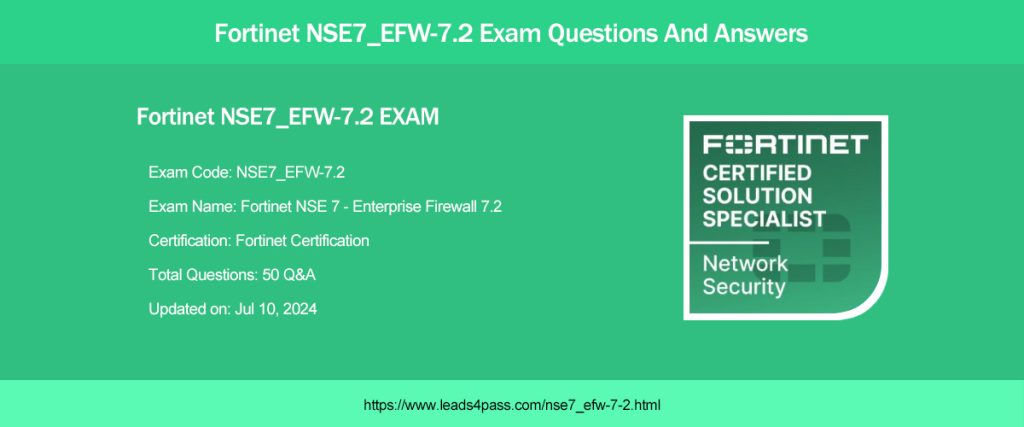
In a recent Leads4Pass NSE7_EFW-7.2 exam material update session, the Fortinet team edited and compiled 50 latest exam questions and answers.
Practice the latest Fortinet NSE7_EFW-7.2 exam questions online
| Number of exam questions | Exam Question Type | Related certifications | Answer |
| 50 | Single-choice and multiple-choice questions | NSE7 | Verify |
Question 1:
Refer to the exhibits, which show the configurations of two address objects from the same FortiGate.
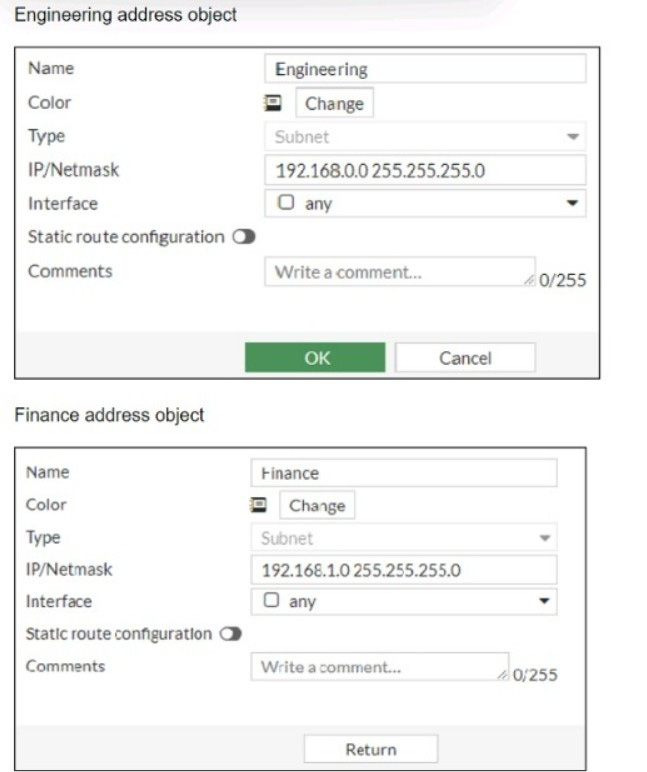
Why can you modify the Engineering address object, but not the Finance address object?
A. You have read-only access.
B. FortiGate joined the Security Fabric and the Finance address object was configured on the root FortiGate.
C. FortiGate is registered on FortiManager.
D. Another user is editing the Finance address object in workspace mode.
Verify your score at the end of the article
Exam question analysis:
The inability to modify the Finance address object while being able to alter the Engineering address object suggests that the Finance object is being managed by a higher authority in the Security Fabric, likely the root FortiGate.
When a FortiGate is part of a Security Fabric, address objects and other configurations may be managed centrally. This aligns with the Fortinet FortiGate documentation on Security Fabric and central management of address objects.
Question 2:
Which, three conditions are required for two FortiGate devices to form an OSPF adjacency? (Choose three.)
A. OSPF interface network types match
B. OSPF router IDs are unique
C. OSPF interface priority settings are unique
D. OSPF link costs match
E. Authentication settings match
Verify your score at the end of the article
Exam question analysis:
Option A is correct because the OSPF interface network types determine how the routers form adjacencies and exchange LSAs on a network segment. The network types must match for the routers to become neighbors1.
Option B is correct because the OSPF router IDs are used to identify each router in the OSPF domain and to establish adjacencies. The router IDs must be unique for the routers to become neighbors2. Option E is correct because the authentication settings control how the routers authenticate each other before exchanging OSPF packets. The authentication settings must match for the routers to become neighbors3.
Option C is incorrect because the OSPF interface priority settings are used to elect the designated router (DR) and the backup designated router (BDR) on a broadcast or non-broadcast multi-access network. The priority settings do not have to be unique for the routers to become neighbors, but they affect the DR/BDR election process4.
Option D is incorrect because the OSPF link costs are used to calculate the shortest path to a destination network based on the bandwidth of the links. The link costs do not have to match for the routers to become neighbors, but they affect the routing decisions5. References: =
1: OSPF network types
2: OSPF router ID
3: OSPF authentication
4: OSPF interface priority
5: OSPF link cost
Question 3:
Which two statements about the Security fabric are true? (Choose two.)
A. FortiGate uses the FortiTelemetry protocol to communicate with FortiAnatyzer.
B. Only the root FortiGate sends logs to FortiAnalyzer
C. Only FortiGate devices with configuration-sync receive and synchronize global CMDB objects that the toot FortiGate sends
D. Only the root FortiGate collects network topology information and forwards it to FortiAnalyzer
Verify your score at the end of the article
Exam question analysis:
In the Security Fabric, only the root FortiGate sends logs to FortiAnalyzer
(B). Additionally, only FortiGate devices with configuration-sync enabled receive and synchronize global Central Management Database (CMDB) objects that the root FortiGate sends
(C). FortiGate uses the FortiTelemetry protocol to communicate with other FortiGates, not FortiAnalyzer
(A). The last option
(D) is incorrect as all FortiGates can collect and forward network topology information to FortiAnalyzer.
References: FortiOS Handbook – Security Fabric
Question 4:
Refer to the exhibit.
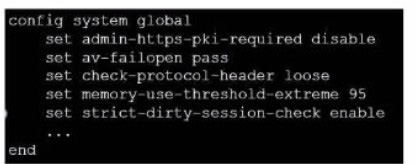
which contains a partial configuration of the global system. What can you conclude from this output?
A. NPs and CPs are enabled
B. Only CP arc disabled
C. Only NPs are disabled
D. NPs and CPs are disabled
Verify your score at the end of the article
Exam question analysis:
The configuration output shows various global settings for a FortiGate device.
The terms NP (Network Processor) and CP (Content Processor) relate to FortiGate\’s hardware acceleration features.
However, the provided configuration output does not directly mention the status (enabled or disabled) of NPs and CPs.
Typically, the command to disable or enable hardware acceleration features would specifically mention NP or CP in the command syntax.
Therefore, based on the output provided, we cannot conclusively determine the status of NPs and CPs, hence option D is the closest answer since the output does not confirm that they are enabled. References: FortiOS Handbook – CLI Reference for FortiOS 5.2
Question 5:
Exhibit.
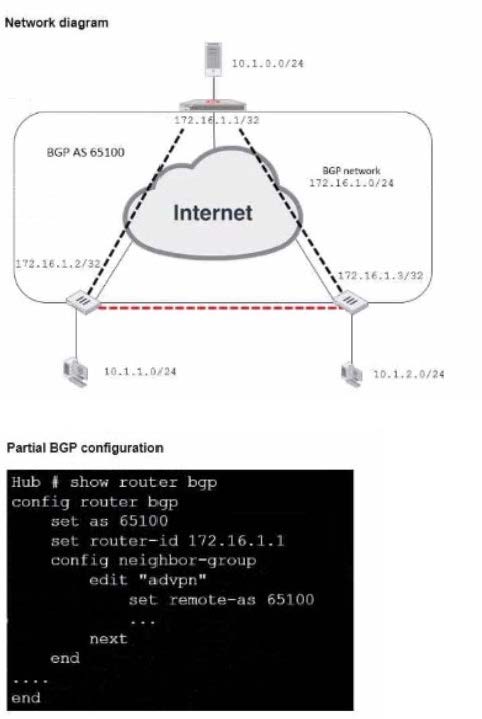
Refer to the exhibit, which contains an ADVPN network diagram and a partial BGP con figuration Which two parameters Should you configure in config neighbor range? (Choose two.)
A. set prefix 172.16.1.0 255.255.255.0
B. set route reflector-client enable
C. set neighbor-group advance
D. set prefix 10.1.0 255.255.255.0
Verify your score at the end of the article
Exam question analysis:
In the ADVPN configuration for BGP, you should specify the prefix that the neighbors can advertise.
Option A is correct as you would configure the BGP network prefix that should be advertised to the neighbors, which matches the BGP network in the diagram.
Option C is also correct since you should reference the neighbor group configured for the ADVPN setup within the BGP configuration.
Question 6:
Refer to the exhibit, which contains information about an IPsec VPN tunnel.

What two conclusions can you draw from the command output? (Choose two.)
A. Dead peer detection is set to enable.
B. The IKE version is 2.
C. Both IPsec SAs are loaded on the kernel.
D. Forward error correction in phase 2 is set to enable.
Verify your score at the end of the article
Exam question analysis:
From the command output shown in the exhibit:
B. The IKE version is 2: This can be deduced from the presence of \’ver=2\’ in the output, which indicates that IKEv2 is being used.
C. Both IPsec SAs are loaded on the kernel: This is indicated by the line \’npu flags=0x0/0\’, suggesting that no offload to NPU is occurring, and hence, both Security Associations are loaded onto the kernel for processing. Fortinet documentation specifies that the version of IKE (Internet Key Exchange) used and the loading of IPsec Security Associations can be verified through the diagnostic commands related to VPN tunnels.
Question 7:
Which two statements about ADVPN are true? (Choose two)
A. auto-discovery receiver must be set to enable on the Spokes.
B. Spoke-to-spoke traffic never goes through the hub
C. lt supports NAI for on-demand tunnels
D. Routing is configured by enabling add-advance-route
Verify your score at the end of the article
Exam question analysis:
ADVPN (Auto Discovery VPN) is a feature that allows to dynamically establish direct tunnels (called shortcuts) between the spokes of a traditional Hub and Spoke architecture.
The auto-discovery receiver must be set to enable the spokes to allow them to receive NHRP messages from the hub and other spokes. NHRP (Next Hop Resolution Protocol) is used for on-demand tunnels, which are established when there is traffic between spokes. Routing is configured by enabling add-nhrp-route, not add-advpn-route.
References:= ADVPN | FortiGate / FortiOS 7.2.0 | Fortinet Document Library, Technical Tip: Fortinet Auto Discovery VPN (ADVPN)
Question 8:
Which FortiGate in a Security I auric sends togs to FortiAnalyzer?
A. Only the root FortiGate.
B. Each FortiGate in the Security fabric.
C. The FortiGate devices perform network address translation (NAT) or unified threat management (UTM). if configured.
D. Only the last FortiGate that handled a session in the Security Fabric
Verify your score at the end of the article
Exam question analysis:
Option B is correct because each FortiGate in the Security Fabric can send logs to FortiAnalyzer for centralized logging and analysis12. This allows you to monitor and manage the entire Security Fabric from a single console and view aggregated reports and dashboards.
Option A is incorrect because the root FortiGate is not the only device that can send logs to FortiAnalyzer. The root FortiGate is the device that initiates the Security Fabric and acts as the central point of contact for other FortiGate devices3.
However, it does not have to be the only log source for FortiAnalyzer.
Option C is incorrect because the FortiGate devices performing NAT or UTM are not the only devices that can send logs to FortiAnalyzer. These devices can perform additional security functions on the traffic that passes through them, such as firewall, antivirus, web filtering, etc. However, they are not the only devices that generate logs in the Security Fabric.
Option D is incorrect because the last FortiGate that handled a session in the Security Fabric is not the only device that can send logs to FortiAnalyzer. The last FortiGate is the device that terminates the session and applies the final security
policy5. However, it does not have to be the only device that reports the session information to FortiAnalyzer. References: =
1: Security Fabric – Fortinet Documentation1
2: FortiAnalyzer Demo6
3: Security Fabric topology
4: Security Fabric UTM features
5: Security Fabric session handling
Question 9:
Exhibit.
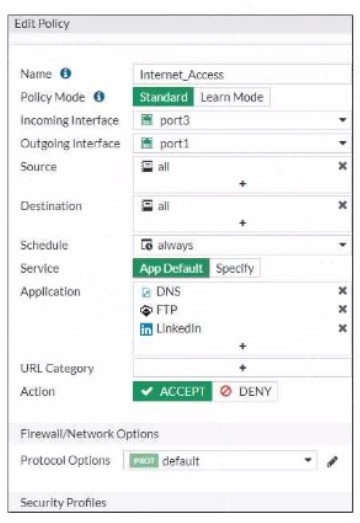
Refer to the exhibit, which contains a partial policy configuration.
Which setting must you configure to allow SSH?
A. Specify SSH in the Service field
B. Configure pot 22 in the Protocol Options field.
C. Include SSH in the Application field
D. Select an application control profile corresponding to SSH in the Security Profiles section
Verify your score at the end of the article
Exam question analysis:
Option A is correct because to allow SSH, you need to specify SSH in the Service field of the policy configuration. This is because the Service field determines which types of traffic are allowed by the policy1. By default, the Service field is set to App Default, which means that the policy will use the default ports defined by the applications. However, SSH is not one of the default applications, so you need to specify it manually or create a custom service for it2.
Option B is incorrect because configuring port 22 in the Protocol Options field is not enough to allow SSH. The Protocol Options field allows you to customize the protocol inspection and anomaly protection settings for the policy3. However, this field does not override the Service field, which still needs to match the traffic type.
Option C is incorrect because including SSH in the Application field is not enough to allow SSH. The Application field allows you to filter the traffic based on the application signatures and categories. However, this field does not override the Service field, which still needs to match the traffic type.
Option D is incorrect because selecting an application control profile corresponding to SSH in the Security Profiles section is not enough to allow SSH. The Security Profiles section allows you to apply various security features to the traffic, such as antivirus, web filtering, IPS, etc. However, this section does not override the Service field, which still needs to match the traffic type. References: =
1: Firewall policies
2: Services
3: Protocol options profiles
4: Application Control
Question 10:
Which ADVPN configuration must be configured using a script on fortiManager, when using VPN Manager to manage fortiGate VPN tunnels?
A. Enable AD-VPN in IPsec phase 1
B. Disable add-route on hub
C. Configure IP addresses on IPsec virtual interlaces
D. Set the protected network to all
Verify your score at the end of the article
Exam question analysis:
To enable AD-VPN, you need to edit an SD-WAN overlay template and enable the Auto-Discovery VPN toggle. This will automatically add the required settings to the IPsec template and the BGP template. You cannot enable AD-VPN directly in the IPsec phase 1 settings using VPN Manager.
References := ADVPN | FortiManager 7.2.0 – Fortinet Documentation
Question 11:
Which two statements about ADVPN are true? (Choose two.)
A. You must disable add-route in the hub.
B. AllFortiGate devices must be in the same autonomous system (AS).
C. The hub adds routes based on IKE negotiations.
D. You must configure phase 2 quick mode selectors to 0.0.0.0 0.0.0.0.
Verify your score at the end of the article
Exam question analysis:
C. The hub adds routes based on IKE negotiations: This is part of the ADVPN functionality where the hub learns about the networks behind the spokes and can add routes dynamically based on the IKE negotiations with the spokes.
D. You must configure phase 2 quick mode selectors to 0.0.0.0 0.0.0.0: This wildcard setting in the phase 2 selectors allows any-to-any tunnel establishment, which is necessary for the dynamic creation of spoke-to-spoke tunnels. These configurations are outlined in Fortinet\’s documentation for setting up ADVPN, where the hub\’s role in route control and the use of wildcard selectors for phase 2 are emphasized to enable dynamic tunneling between spokes.
Question 12:
Exhibit.
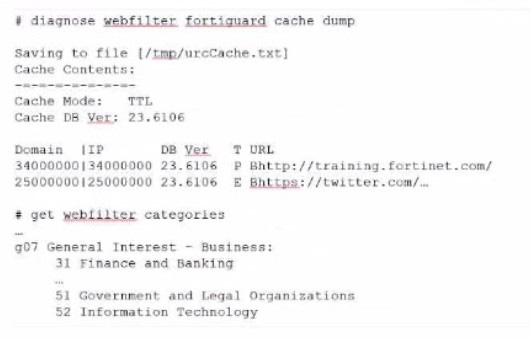
Refer to the exhibit, which shows the output from the web filter fortiguard cache dump and web filter categories commands.
Using the output, how can an administrator determine the category of the training? Fortinet.comam website?
A. The administrator must convert the first three digits of the IP hex value to binary
B. The administrator can look up the hex value of 34 in the second command output.
C. The administrator must add both the Pima in and Iphex values of 34 to get the category number
D. The administrator must convert the first two digits of the Domain hex value to a decimal value
Verify your score at the end of the article
Exam question analysis:
Option B is correct because the administrator can determine the category of the training.fortinet.com website by looking up the hex value of 34 in the second command output. This is because the first command output shows that the domain and the IP of the website are both in category (Hex) 34, which corresponds to Information Technology in the second command output1.
Option A is incorrect because the administrator does not need to convert the first three digits of the IP hex value to binary. The IP hex value is already in the same format as the category hex value, so the administrator can simply compare them without any conversion2.
Option C is incorrect because the administrator does not need to add both the Pima in and Iphex values of 34 to get the category number. The Pima in and Iphex values are not related to the category number but to the cache TTL and the database version respectively3.
Option D is incorrect because the administrator does not need to convert the first two digits of the Domain hex value to a decimal value. The Domain hex value is already in the same format as the category hex value, so the administrator can simply compare them without any conversion2. References: =
1: Technical Tip: Verify the web filter cache content
2: Hexadecimal to Decimal Converter5
3: FortiGate – Fortinet Community6 : Web filter | FortiGate / FortiOS 7.2.0 – Fortinet Documentation7
Question 13:
Refer to the exhibit, which shows two configured FortiGate devices and peering over FGSP.
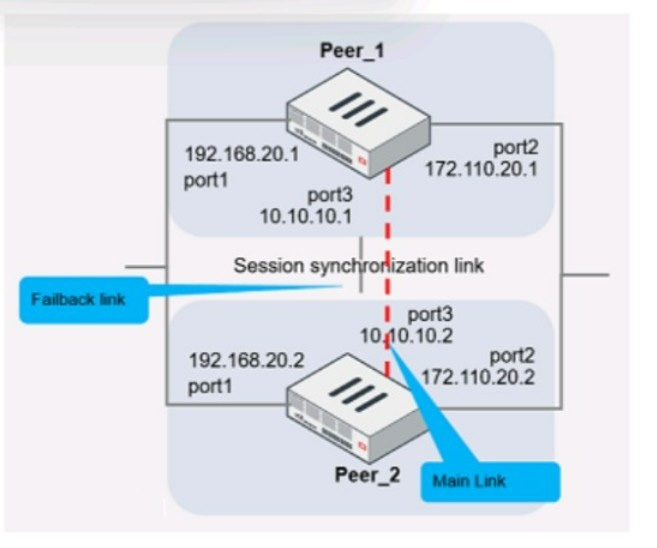
The main link directly connects the two FortiGate devices and is configured using the set session-syn-dev command.
What is the primary reason to configure the main link?
A. To have both sessions and configuration synchronization in layer 2
B. To load balance both sessions and configuration synchronization between layers 2 and 3
C. To have only configuration synchronization in layer 3
D. To have both sessions and configuration synchronization in layer 3
Verify your score at the end of the article
Exam question analysis:
The primary purpose of configuring a main link between the devices is to synchronize session information so that if one unit fails, the other can continue processing traffic without dropping active sessions.
A.To have both sessions and configuration synchronization in layer 2. This is incorrect because FGSP is used for session synchronization, not configuration synchronization. B.To load balance both sessions and configuration synchronization
between layers 2 and 3.FGSP does not perform load balancing and is not used for configuration synchronization.
C.To have only configuration synchronization in layer 3. The main link is not used solely for configuration synchronization.
D.To have both sessions and configuration synchronization in layer 3. The main link in an FGSP setup is indeed used to synchronize session information across the devices, and it operates at layer 3 since it uses IP addresses to establish the peering.
Question 14:
Refer to the exhibit, which shows an error in the system fortiguard configuration.

What is the reason you cannot set the protocol to udp in the config system format?
A. FortiManager provides FortiGuard.
B. fortiguard-anycast is set to enable.
C. You do not have the corresponding write access.
D. udp is not a protocol option.
Verify your score at the end of the article
Exam question analysis:
The reason for the command failure when trying to set the protocol to UDP in the theconfig system is likely that UDP is not a protocol option in this context. The command syntax might be incorrect or the option to set a protocol for FortiGuard updates might not exist in this manner. So the correct answer is D. udp is not a protocol option.
Question 15:
Exhibit.
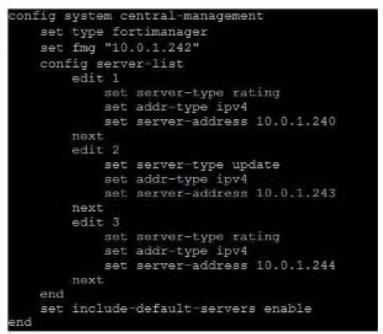
Refer to the exhibit, which shows a central management configuration
Which server will FortiGate choose for web filler rating requests if 10.0.1.240 is experiencing an outage?
A. Public FortiGuard servers
B. 10.0.1.242
C. 10.0.1.244
D. 10.0.1.243
Verify your score at the end of the article
Exam question analysis:
In the event of an outage at 10.0.1.240, FortiGate will choose the next server in the sequence for web filter rating requests, which is 10.0.1.244 according to the configuration shown in the exhibit. This is because the server list is ordered by priority, and the server with the lowest priority number is chosen first. If that server is unavailable, the next server with the next lowest priority number is chosen, and so on. The public FortiGuard servers are only used if the include-default servers option is enabled and all the custom servers are unavailable. References Fortinet Enterprise Firewall Study Guide for FortiOS 7.2, page 132.
…
Verify answer
| Q1 | Q2 | Q3 | Q4 | Q5 | Q6 | Q7 | Q8 | Q9 | Q10 | Q11 | Q12 | Q13 | Q14 | Q15 |
| B | ABE | BC | D | AC | BC | AC | B | A | A | CD | B | D | D | C |
When to Seek Help with Leads4Pass NSE7_EFW-7.2 Exam Materials
Leads4Pass NSE7_EFW-7.2 exam materials are the best practice materials to help you successfully pass your exam! Even beginner candidates can use materials to help practice and improve their exam skills
Fortinet NSE 7 – Enterprise Firewall 7.2 certification exam requires candidates to answer 30 questions in 60 minutes. Passing the exam can earn network security certification exam badges:
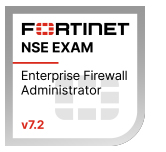
Download Fortinet NSE7_EFW-7.2 exam questions and answers with PDF and VCE: https://www.leads4pass.com/nse7_efw-7-2.html, which fully covers the following core topics to help you successfully pass Fortinet NSE 7 – Enterprise Firewall 7.2 Exam.
Exam Topics:
System configuration:
- Implement the Fortinet Security Fabric
- Configure hardware acceleration
- Configure different operation modes for an HA cluster
Central management:
- Implement central management
Security profiles
- Use FortiManager as a local FortiGuard server
- Configure web filtering
- Configure application control
- Configure the intrusion prevention system (IPS) in an enterprise network
Routing:
- Implement OSPF to route enterprise traffic
- Implement Border Gateway Protocol (BGP) to route enterprise traffic
VPN:
- Implement IPsec VPN IKE version 2
- Implement auto-discovery VPN (ADVPN) to enable on-demand VPN tunnels between sites
Discover more from Share Fortinet dumps questions online (NSE4,NSE5,NSE6,NSE7,NSE8)
Subscribe to get the latest posts sent to your email.